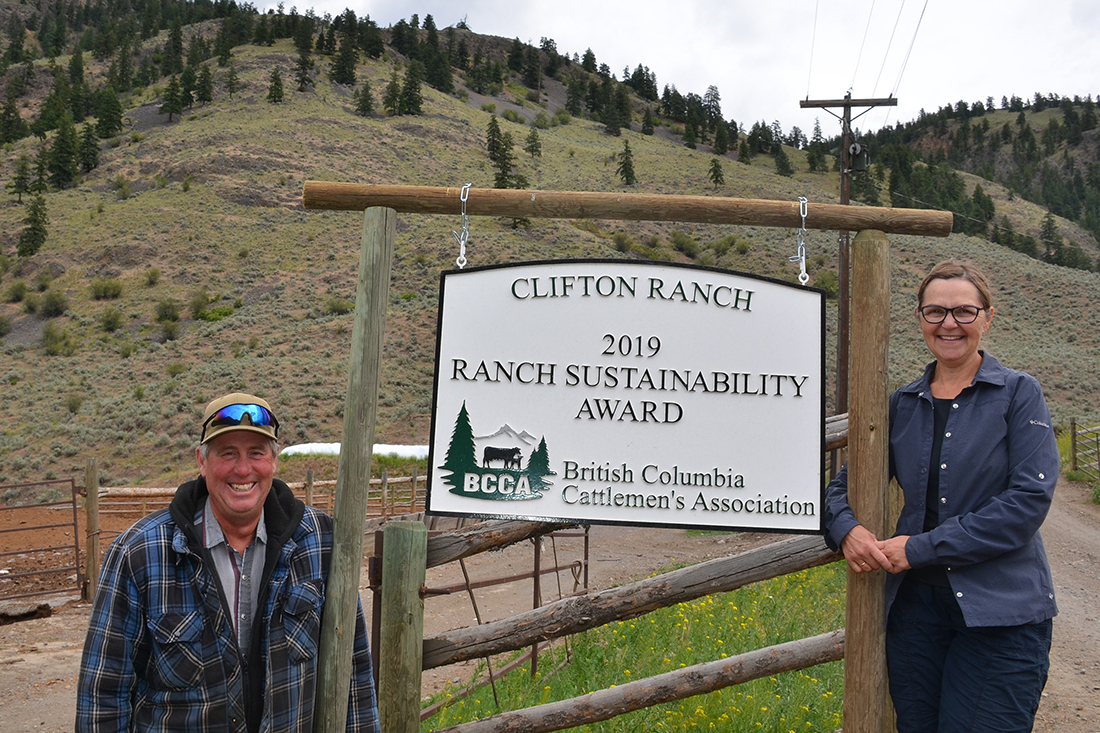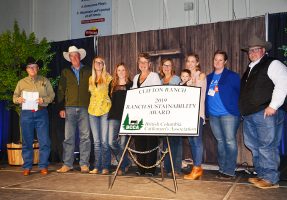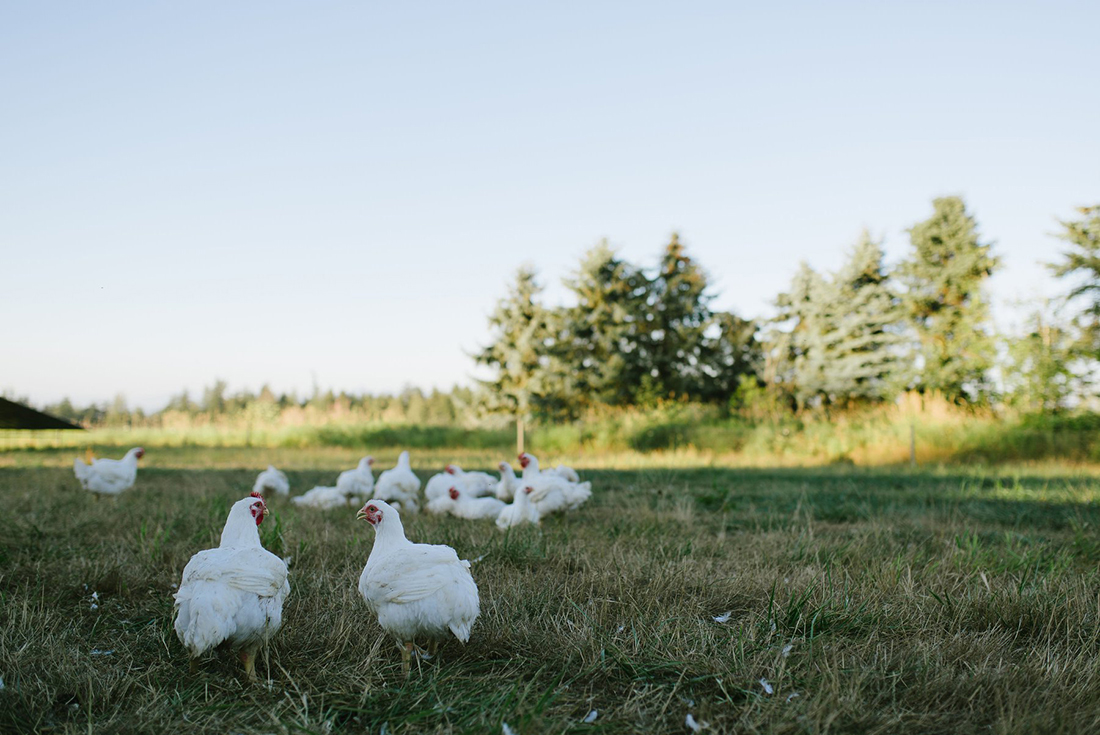KEREMEOS—The Clifton family was extremely pleased to receive the 2019 Ranch Sustainability Award from the BC Cattlemen’s Association, but the initiatives designed to improve habitat on the family’s ranch weren’t done for attention.
“We didn’t start out to do this with the idea of winning an award,” says Wade Clifton, who undertook the projects with his brother Brad, who died in February. “We did it so that we could better manage the grass for our herd and grow more pounds of beef.”
It’s a tough place to manage grass. Clifton Ranch sits by Olalla on Hwy. 3A at the north entrance to the Similkameen valley. Its range is east over White Lake into Okanagan Falls and west through to Princeton and takes in some of the hottest and driest grasslands in the province.
“On the slopes next to White Lake, it can regularly reach 45 [degrees] Celsius,” says Clifton. Rainfall averages around 12 inches a year.
A key part of the sustainability equation for the Cliftons is economics.
“A project had to make economic sense before we developed it,” says Clifton.
An investment in a water system for example, will support the development of better grazing for the cattle and it will also enhance the restoration of a riparian area.
But one objective doesn’t outweigh the other. What’s good for the cattle is also good for the habitat.
Range cattle will gather where there’s water.
“When we had them drinking out of Horn Lake, the riparian area was heavily impacted by all the traffic, but the hillsides were quite scoured as well,” notes Clifton.
Initially, the cattle would overgraze the bottom grass closest to the lake.
“They would eventually move up the mountain for better grass, but then they would track back down to drink and they wore paths into the soil that would start to erode the hillsides,” he explains.
Brad Clifton’s solution was to install a 1,700-foot, high-elevation spring-sourced water line connecting nine water troughs located across the hillside. This led to multiple benefits.
“The first thing it did was to lure the cattle out of the bottom riparian area up to where there was better grass so that they ate better,” says Clifton.
The multiple troughs spread the cattle over a broader area, leading to less impact on the grass. The cattle began grazing across the slope rather than up and down the hillside, reducing impacts on the land. The riparian area saw less traffic, so it had a chance to recover, too.
In the long run, the cattle eat better, gain weight and put more dollars into the Cliftons’ pockets.
Overall, the Cliftons have 100 water developments. Some are gravity-fed systems, others are as simple as a collection trough on a small spring.
Any riparian fencing has a wildlife-friendly design. The top and bottom strands are plain wire with the middle three stands barbed.
“When deer go over it they are not going to catch a barb on their coat causing an injury and possibly ripping the fence,” explains Clifton. “It’s easier on the animals and we spend less time fixing fences.”
Clifton shows another range area that is also supported by a trough system and points out the unfenced creek bottom.
“When the cattle have access to water up in the hills, they don’t regularly come down to the creek,” he points out. “We don’t have to fence them out of the riparian area because they are only there for a couple of days to eat the grass and then they move up the hill and don’t come back.”
That dry Similkameen grassland is also home to 31 species at risk. As Ottawa identified and developed plans for the protection of these species on federal grazing lands, discussions with ranchers centered on the presence of cattle.
“They said if they remove the cattle we are going to help the species at risk,” Clifton recalls. “And I asked, is it going to help them?”
Challenging the conventional wisdom was mighty scary at first, but the Cliftons explained how the cattle were a key part of the grasslands ecosystem. Each individual species requires a diverse habitat and removing the cattle would significantly alter that diversity.
“Cattle have been grazing on that land for over 100 years,” notes Clifton. “The species that live there do so because the habitat supports them, and cattle are a significant part of that habitat.”
The family has won recognition for its work with the Nature Trust of BC in developing a range management plan that incorporates cattle to restore grasslands around White Lake. The White Lake Biodiversity Ranch is now a showcase property in the Nature Trust’s portfolio.
“They are 100% on-side with how we are managing,” says Clifton.
The Cliftons had bought half of White Lake Ranch, which is the middle of their range area, and Nature Trust had bought the other half hoping to restore areas which were overgrazed.
Clifton says the plan initially called for fencing off the grasslands to keep cattle out but it wasn’t working. That’s when they approached the Cliftons about a partnership.
“We asked them to consider what the cattle might do to help restore the grass,” says Clifton. “We showed them how, when grass is grazed at the right time, it stimulates a strong regrowth. We pointed out the weeds that the cattle would eat and we explained how closely we monitor and time our grazing.”
Indeed, timing is a key to the Clifton’s grazing plan.
“We watch our grasslands really closely to time our turn-out,” he says. “We don’t look at the calendar, we look at the grass to know when it is ready.”
In the most sensitive areas around White Lake, the cattle are on for just two weeks, sometimes with a three-year gap.
“This is a 50-year process,” notes Clifton. “When the grasslands are depleted in this hot, dry, environment, it takes a long time to recover.”
The restoration is starting to show success. Clifton points to a control area that is fenced off and has not had cattle grazing. That pasture has poor forage growth with weeds choking out the grass. Across the road, a grazed field has taller, healthier grass and fewer weeds.
The non-grazed area might eventually recover, says Clifton.
“The weeds might reach a point after a number of years where they crash, and the grass has a chance to come back,” he says. “But it is a lot of waiting for an unknown outcome.”
Due to the unique ecosystem and the location, there are multiple agencies that have interests in the grasslands of the South Okanagan and Similkameen. It is obvious from spending time with Clifton that his low-key, yet highly informed manner would come to be respected among the various interest groups and government agencies he deals with.
For the family, being recognized with the sustainability award creates opportunities to share their story of how cattle can support an ecosystem rather than damage it.
“What I am hoping more than anything is that it shows that cattlemen are actually doing the right thing to maintain our grasslands,” says Clifton. “I hope we can train people to u



